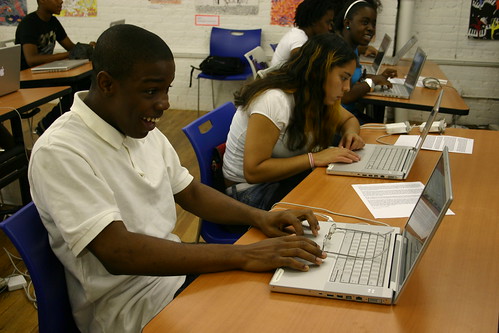
Today was the last day of the "I Dig Zambia" virtual summer camp, and I have been reflecting on how our Global Kids teens participated in the program. For the past two weeks, eleven of our Global Kids teens have been going through a virtual summer camp in Teen Second Life with eight other teens in Chicago to learn about science and society in Zambia. It's been a really amazing experience for all of us.
That said, I think there were some significant differences between the two teams of students that played a part in how they participated and what they took away from the experience.
Our New York teens fall on the lower end of the socioeconomic spectrum and for the most part don't have regular access to computers or broadband internet as part of their regular lives. Their Chicago counterparts tend to come from more affluent backgrounds and presumably do have access to computers and internet at home and elsewhere.
For the most part, these differences weren't too apparent. Second Life enables all our teens to appear basically in whatever shape, gender, size, or color they wish. Most of them were new to Second Life at the beginning of the program, so we all kind of flailed along together. It's one of the nice aspects of the virtual world — it can level out some of the various ways that some youth get marginalized and held back.
The differences manifested themselves in interesting ways though, that I think are instructive for how we design our virtual world education programs for the future.
The way that our Global Kids teens shine in our regular, offline programs is through verbal engagement, respectful debate, and creative expression. Our teens are rambunctious, hilarious, and explosively energetic.
But much of what makes them special in our offline programs does not readily translate to their actions in the virtual world. They can't just have their avatar stand up and do a silly dance for the other kids, or shout out a clever retort, or create a beautiful piece of art in Second Life. They just don't have the skills or the comfort level to be that expressive yet. And it clearly frustrated several of them.
The Chicago teens seemed to get how much Second Life privileges being able to readily communicate over typed chat. (We restricted the use of voice chat to the educators.) And more of them became versed in how to use the 3D creation tools of Second Life to express themselves. Whenever we would pose a question to our teens in New York and Chicago, inevitably the Chicago teens would type their answers more quickly. In New York, we were constantly having to tell our teens to "type don't talk" after they would shout out the answers to questions that we posed.
At one point in a discussion, one of our teens exclaimed, "I have a comment!"
"Type it," my co-educator Shawna replied, pointing to the teen's keyboard.
"But… but… it's like a paragraph," he complained, frustrated. He didn't end up answering the question at all.
There are so many skills that go into being a "digital native" versus an "immigrant." Being able to touch type quickly, use a trackpad, and learn key combinations are some of those basic skills that are a real leg-up for the teens that have them. And a source of frustration for the kids that don't.
In my opinion, the virtual worlds support the marginalized youths. It helps the chidren exempt themselves from marginalization and differences.